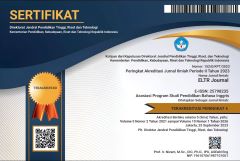ARTIFICIAL INTELLIGENCE AS A LEARNING MEDIA IN ENGLISH EDUCATION: BIBLIOMETRIC USING BIBLIOSHINY ANALYSIS (2009-2023)
Abstrak terlihat: 828 / PDF terunduh: 750DOI:
https://doi.org/10.37147/eltr.v8i1.179Keywords:
artificial intelligence, bibliometric, English educationAbstract
This research examines the publication trends and emerging keywords within the domain of artificial intelligence applied to English education. Analyzing 74 documents sourced from Scopus using RStudio and Vosviewer revealed distinct patterns. Notably, the year 2021 marked a significant milestone with 26 articles, constituting 35.14% of total publications, while the preceding decade (2009-2020) contributed only 13 articles, representing less than 18%. However, the period from 2021 to 2023 experienced a noteworthy surge, introducing over 80% of the total publications, incorporating 60 new articles. Esteemed institutions like Hebei University of Engineering in China and three other affiliates each contributed 4 publications. The prominence of the ACM International Conference Proceedings Series underscores the influential role of technology conferences in shaping discussions around artificial intelligence in English education. An influential article, cited 20 times, focused on the integration of 5G and AI technologies to reform English education at universities, considering the necessity of cutting-edge technological infrastructure. Visual analysis highlights specific keywords such as speech recognition, quality control, teaching systems, and learning algorithms within yellow circles, suggesting potential areas for further research in the intersection of artificial intelligence and English education.
Downloads
References
Aria, M., & Cuccurullo, C. (2017). Bibliometrix: An R-tool for comprehensive science mapping analysis. Journal of Informetrics, 11(4), 959–975. http://dx.doi.org/10.1016/j.joi.2017.08.007
Cheng, L. K., Selamat, A., Alias, R. A., Puteh, F., & Mohamed, F. B. (2017). InterviewME: A comparative pilot study on M-learning and MAR-learning prototypes in Malaysian English language teaching. Computational Intelligence in Information Systems: Proceedings of the Computational Intelligence in Information Systems Conference (CIIS 2016), 219–234.
Cuccurullo, C., Aria, M., & Sarto, F. (2016). Foundations and trends in performance management: A twenty-five-year bibliometric analysis in business and public administration domains. Scientometrics, 108, 595–611. http://dx.doi.org/10.1007/s11192-016-1948-8
Ekayani, P. (2017). Pentingnya penggunaan media pembelajaran untuk meningkatkan prestasi belajar siswa. Jurnal Fakultas Ilmu Pendidikan Universitas Pendidikan Ganesha Singaraja, 2(1), 1–11.
Fitriani, A. (2023). Biblioshiny: Implementation of artificial intelligence in education (1976-2023). Journal of Technology Global, 1(01), 11–25.
Hakim, M. L., & Angga, M. (2023). ChatGPT open AI: Analysis of mathematics education students learning interest. Journal of Technology Global, 1(01), 1–10.
Kurniaaji, B., Muryani, C. H., & Sarwono, S. (2018). Development of geography learning media on earth evolution history using Adobe Flash. IOP Conference Series: Earth and Environmental Science, 145(1), 1-7. https://doi.org/10.1088/1755-1315/145/1/012034
Ma’rufah, A. (2022). Implementasi pendidikan karakter dalam digitalisasi pendidikan. Edukasia: Jurnal Pendidikan Dan Pembelajaran, 3(1), 17–29.
Maulana, I., Umam, K., Saputra, A. R., Al Amin, H., & Rosyani, P. (2023). Teknologi berbasis kecerdasan buatan pada aplikasi Grab penumpang maupun driver menggunakan metode forward chaining. BINER: Jurnal Ilmu Komputer, Teknik Dan Multimedia, 1(3), 505–509.
Nurrita, T. (2018). Pengembangan media pembelajaran untuk meningkatkan hasil belajar siswa. Jurnal Misykat, 3(1), 171–187.
Prasetyo, A. A., & Rosyid, H. A. (2022). Tinjauan pengaruh kecerdasan buatan terhadap pembelajaran untuk menghadapi masa society 5.0. Jurnal Inovasi Teknologi Dan Edukasi Teknik (JITET), 2(6), 261-271.
Rezeki, S., Andrian, D., Wahyuni, A., & Nurkholisah, H. (2020). The sustainability concept of Riau cultures through development of mathematics learning devices based on Riau folklore at elementary schools. Journal of Physics: Conference Series, 1538(1), 1-10. https://doi.org/10.1088/1742-6596/1538/1/012066
Ririh, K. R., Laili, N., Wicaksono, A., & Tsurayya, S. (2020). Studi komparasi dan analisis swot pada implementasi kecerdasan buatan (Artificial Intelligence) di Indonesia. Jurnal Teknik Industri, 15(2), 122–133.
Rochmah, T. S. (2023). Analisis membangun keterlibatan dan komunikasi gen z dengan kecerdasan buatan di pendidikan tinggi. NUSRA: Jurnal Penelitian Dan Ilmu Pendidikan, 4(3), 694–699.
Shin, M.-H. (2018). How to use artificial intelligence in the English language learning classroom. Indian Journal of Public Health Research & Development, 9(9), 557. http://dx.doi.org/10.5958/0976-5506.2018.01058.6
Sidabutar, H., & Munthe, H. P. (2022). Artificial Intelligence dan implikasinya terhadap tujuan pembelajaran pendidikan agama Kristen. JMPK: Jurnal Manajemen Pendidikan Kristen, 2(2), 76–90.
Sidiq, M. (2019). Panduan analisis bibliometrik sederhana. https://doi.org/10.13140/RG.2.2.15688.37125
Sun, X. (2021). 5G joint artificial intelligence technology in the innovation and reform of university English education. Wireless Communications and Mobile Computing, 2021, 1–10.
Supinah, R., & Soebagyo, J. (2022). Analisis bibliometrik terhadap tren penggunaan ICT pada pembelajaran matematika. JNPM (Jurnal Nasional Pendidikan Matematika), 6(2), 276–290.
Tanjung, R., Supriani, Y., Arifudin, O., & Ulfah, U. (2022). Manajemen penyelenggaraan pendidikan inklusi pada lembaga pendidikan Islam. JIIP-Jurnal Ilmiah Ilmu Pendidikan, 5(1), 339–348.
Wulandari, A. P., Salsabila, A. A., Cahyani, K., Nurazizah, T. S., & Ulfiah, Z. (2023). Pentingnya media pembelajaran dalam proses belajar mengajar. Journal on Education, 5(2), 3928–3936.
Yuan, X. (2021). Retracted: Design of college English teaching information platform based on artificial intelligence technology. Journal of Physics: Conference Series, 1852(2), 22031.
Yunanto, A. A., Herumurti, D., Rochimah, S., & Kuswardayan, I. (2019). English education game using non-player character based on natural language processing. Procedia Computer Science, 161, 502–508.
Zafrullah, Z., Bakti, A. A., Riantoro, E. S., Kastara, R., Prasetyo, Y. B. A., Rosidah, R., Fitriani, A., Fitria, R. L., Ramadhani, A. M., & Ulwiyah, S. (2023). Item response theory in education: A biblioshiny analysis (1987-2023). Journal of Education Global, 1(1), 101–114.
Zafrullah, Z., Suyanto, S., Wahyuni, A., Ayuni, R. T., & Novilanti, F. R. E. (2023). Development of android-based learning to improve computational thinking skills in junior high school. Jurnal Cendekia: Jurnal Pendidikan Matematika, 7(2), 1309–1320.
Zafrullah, Z., & Zetriuslita, Z. (2021). Learning interest of seventh grade students towards mathematics learning media assisted by Adobe Flash CS6. Math Didactic: Jurnal Pendidikan Matematika, 7(2), 114–123. https://doi.org/10.33654/math.v7i2.1272
Zahwa, F. A., & Syafi’i, I. (2022). Pemilihan pengembangan media pembelajaran berbasis teknologi informasi. Equilibrium: Jurnal Penelitian Pendidikan Dan Ekonomi, 19(01), 61–78.
Downloads
Published
How to Cite
Issue
Section
License
Copyright (c) 2024 Zafrullah Zafrullah, Adinda Meisya, Rizki Tika Ayuni

This work is licensed under a Creative Commons Attribution-ShareAlike 4.0 International License.













